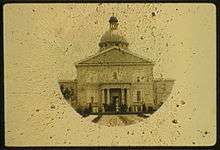Microphotograph
Microphotographs are photographs shrunk to microscopic scale.[2] Microphotography is the art of making such images. Applications of microphotography include espionage such as in the Hollow Nickel Case, where they are known as microfilm.

Using the daguerreotype process, John Benjamin Dancer was one of the first to produce microphotographs, in 1839.[3] He achieved a reduction ratio of 160:1. Dancer perfected his reduction procedures with Frederick Scott Archer’s wet collodion process, developed in 1850–51, but he dismissed his decades-long work on microphotographs as a personal hobby, and did not document his procedures. The idea that microphotography could be no more than a novelty was an opinion shared by the 1858 Dictionary of Photography, which called the process "somewhat trifling and childish."[4]
Novelty viewing devices such as Stanhopes were once a popular way to carry and view microphotographs.[2]
An important application of microphotography is in microforms.
See also
References
- Kristi Finefield (June 13th, 2012), "Caught Our Eyes: On the Head of a Pin", Picture This: Library of Congress Prints and Photos
- Focal encyclopedia of photography By Michael R. Peres Focal Press, 2007 ISBN 9780240807409, 846 pages
- Lance Day and Ian McNeil (1998). Biographical Dictionary of the History of Technology. Taylor & Francis. p. 333–334. ISBN 9780415193993.
- Sutton, Thomas (1976). "Microphotography". In Veaner, Allen B. (ed.). Studies in micropublishing, 1853–1976: documentary sources. Westport, Conn: Microform Review Inc. p. 88. ISBN 0-913672-07-6. Originally published in Dictionary of Photography (1858).